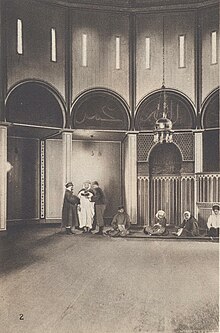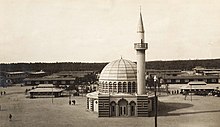Wünsdorf mosque

The mosque in Wünsdorf was the oldest mosque in Germany. It existed from 1915 to 1930 and was located in the so-called Halbmondlager , a prisoner- of- war camp from the First World War , in Wünsdorf . Buildings that were built in the past with the appearance of mosques, for example in Potsdam ( steam engine house for Sanssouci ) or in the palace gardens of Schwetzingen , were not intended for Muslim worship, but were used for decorative purposes.
Coordinates: 52 ° 10 '2.3 " N , 13 ° 29" 0.2 " E
prehistory
The German ambassador in Istanbul, Hans von Wangenheim , reported to Berlin on November 11, 1914 that Sultan Mehmet V wished to build a mosque for Muslim prisoners of war in Germany. The idea was attractive to the German authorities. The half-moon camp (for Indian, North African, Syrian internees, a maximum of 4,000 people) and the neighboring vineyard camp (for interns from French colonies and Tatars , a maximum of 12,000 people) were characterized by the fact that it was made easier for the prisoners to obey Muslim laws. So they should be won for the German jihad against the colonial powers Russia, France and Great Britain. The German jihad is a concept of the German diplomat Max von Oppenheimer to mobilize around 300 million Muslims who lived under colonial rule against the colonial powers using the news center for the Orient . In this context, jihad is not to be understood in the current sense of a war against non-Muslims, but as a strategy in the First World War . In total, almost 2000 of the up to 16,000 internees followed the sultan's call to join the Ottoman army . However, their integration into this army failed, and many volunteers deserted because of the bad treatment. That is why the advertising campaign was discontinued in 1916.
Building description
In February 1915, the Ministry of War granted permission for the mosque to be built.
The Charlottenburg company Stiebitz und Köpchen erected the building for 45,000 gold marks in five weeks . It was a wooden building with board cladding on both sides on solid foundation walls.
The core building was a polygonal , centrally domed prayer room with a walkway; The latter was by clerestory deducted from the dome and had a pent roof . In the south there was an anteroom with a preacher's room, a mortuary washroom and a minaret . In the north there was a roughly square courtyard with a square fountain and foot tubs. To the north there was a bathhouse.
The interior and exterior painting was done with oil paint, the base color was ivory white with red and gray stripes. The prayer room was laid out with stone slabs on which mats were placed. The minaret was 23 meters high. The central dome was 12 meters in diameter. Since the Muslims came from different countries of origin, the eclectic mosque building in the service of psychological warfare deliberately combined "elements of Western Islamic buildings in Spain, the Dome of the Rock , Ottoman mosques up to the Taj Mahal in Agra."
Use and demolition
On July 13, 1915, with the beginning of Ramadan , the new mosque was inaugurated in the presence of the Turkish diplomat Mahmut Muhtar Pascha .
After the end of the First World War , the Muslim internees gradually returned to their countries of origin. A group of 90 Muslims stayed in two of the barracks near the mosque and, with the approval of the authorities, continued religious life in Wünsdorf.
When the foundation stone for the mosque in Berlin-Wilmersdorf was laid in 1924 , the motivation to continue using the temporary wooden structure in Wünsdorf ceased to exist. In 1927 the “Society for Islamic Worship” offered to sell the Wünsdorf mosque to the German state for 10,000 Reichsmarks and to use the money for the new Wilmersdorf building. When the Wilmersdorfer mosque was completed in 1928, the demolition of the Wünsdorf building was the logical consequence. It took place in 1930. During the National Socialist era , the area was covered with functional military buildings.
Archaeological investigation after 100 years
On July 13, 2015, a teaching and research excavation began by the Brandenburg State Office for Monument Preservation and the Institute for Near Eastern Archeology at the Free University of Berlin on the former mosque site. The construction history of the Wünsdorf ground monument 48 “POW camp 1914–1918 with the location of a mosque” was to be documented in preparation for the planned new construction of an initial reception facility for refugees at this point.
The central building and the northern porch of the mosque were located under today's parking lot and were not affected by the construction work. The excavation was therefore aimed at the southern porch with the minaret. The archaeologists found remains of foundations made from industrially manufactured bricks with line mortar and cement slabs. These remains belonged to the washroom and bathroom. The irrigation and drainage system of this facility was also verifiable. As far as the actual prayer room was concerned, it was found that the bricks of the foundations and the floor slabs had been purposefully cleared during the demolition, presumably in order to use them again. What remained was rubble: chunks of screed, iron bracing, fragments of the chandeliers and colored pieces of glass from dome windows and lamps.
The current use of the site as a container complex in which refugees live “contains the bitter irony that a ... not exactly successful plan of religious-military aggression, jihad , originated in a place where its victims would have to seek protection a hundred years later - under spatial conditions that are not at all unlike those who lived there at the time. "
An information board and the name of the Mosque Street that runs there remind of Germany's oldest mosque.
Web links
- Klaus Raab: A functional building branded Felsendom . In: Zeit Online, July 12, 2015.
- Matthias Lohre: Half moon over Brandenburg . In: Zeit Online, December 11, 2015.
literature
- Martin Gussone: The mosque in the Wünsdorf "half-moon camp". Between jihād propaganda and orientalism. In: Contributions to Islamic Art and Archeology , 2010 year, issue 2, pp. 204–231.
- Torsten Dressler et al .: Half moon over Wünsdorf. Mosque in the prisoner of war camp 1915. In: Communications of the German Society for Archeology of the Middle Ages and Modern Times , Volume 30, 2017, pp. 125–136. ( PDF )
- Martin Gussone: The construction of the mosque in the Wünsdorfer crescent camp. In: Gesellschaft für Bautechnikgeschichte (ed.): "With the cheapest means, durable, fire-safe and convenient". Thrift as a principle, rationality as a worldview? (= Series of publications by the Society for the History of Building Technology , Volume 2.) Thelem, Dresden 2019, ISBN 978-3-95908-478-9 , pp. 335–338.
Individual evidence
- ↑ a b c Matthias Lohre: Half moon over Brandenburg. December 11, 2015, accessed December 31, 2018 .
- ↑ a b Klaus Raab: Mosque: A functional building brand Dome of the Rock . In: The time . July 12, 2015, ISSN 0044-2070 ( zeit.de [accessed February 1, 2019]).
- ↑ a b c d Klaus Raab: A functional building brand Felsendom. July 12, 2015, accessed December 31, 2018 .
- ^ Crescent moon over Wünsdorf . S. 126 .
- ↑ a b c crescent moon over Wünsdorf . S. 127 .
- ↑ On the trail of Germany's oldest mosque. Archaeologists from the Free University found remains of the first Muslim house of prayer. In: FU-Berlin, campus life. October 12, 2015, accessed January 1, 2019 .
- ^ Crescent moon over Wünsdorf . S. 131.134 .
- ^ Crescent moon over Wünsdorf . S. 135 .

